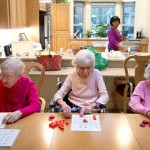 Today’s New York Times featured an article on a new, and quickly spreading, effort to deinstitutionalize nursing homes by changing their physical structure. Instead of occupying a vast hospital-like building, these new nursing homes are made up of clusters of arts-and-crafts style houses called “Green Houses.”
Today’s New York Times featured an article on a new, and quickly spreading, effort to deinstitutionalize nursing homes by changing their physical structure. Instead of occupying a vast hospital-like building, these new nursing homes are made up of clusters of arts-and-crafts style houses called “Green Houses.”
Each Green House is home to approximately ten residents. The floor plans are open and lead to interaction between staff and residents. For instance, food for the residents is prepared in a warm open kitchen, instead of some industrial-grade cafeteria, and residents will often make small talk with the cooks as they prepare their food.
There are currently 117 Green House nursing homes in the United States, with plans for more.
Residents of Green Houses experience fewer bed sores than those in conventional nursing homes, according to one survey, and each day they get 24 minutes more of direct and personalized care and 1.5 hours more of nursing staff time than those living in traditional nursing homes.
The cost of nursing care in a Green House is approximately the same as the cost of nursing care in a traditional nursing home, but the per-patient construction costs of building a Green House are slightly higher than cost of building a traditional nursing home.
Let’s hope the Green House movement catches on.
(A side note: thanks to a talented client who recently introduced me to the wonders of Greene & Greene‘s arts-and-craft furniture and architecture, I thought the “Green House” movement’s arts-and-crafts houses might have taken their inspiration from Greene & Greene, but, alas, it appears they are so named because the “Green Houses” originated with the Green Hill nursing home corporation).

